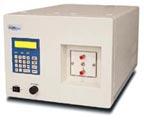|
Instrument Database:
Jasco Inc. - CD-2095 Circular Dichroism Detector
| |
|

|
| |
|
| |
|
| Year of introduction |
|
| Status |
available |
| Company |
Jasco Inc.
|
| Categories |
Chromatography:
|
|
The CD-2095 has been developed as an innovative Circular Dichroism detector, fully optimised to meet HPLC requirements. The CD-2095 detector simultaneously determines both CD and UV absorption of the sample, for direct determination of optical purity. Circular Dichroism is a much more specific technique than OR (Optical Rotation). In the past, large and expensive CD spectropolarimeters have often been modified for use as CD detectors in an HPLC system. The CD-2095 can easily be interfaced with JASCO HPLC systems using HSS-2000 HPLC System software Windows 2000. Features - Unique and unmatched sensitivity and stability
- Simultaneous CD and UV detection with g factor
- Direct Optical Purity determination
- Compact, easy to use package
- Universal HPLC compatibility including gradient!
- Spectral scanning capability
- SFC compaible cells
Introduction to chiral detectors Chiral separation is one of the most important applications of HPLC. The use of chiral chromatography is growing in a number of fields, including drug analysis, drug discovery, biochemical analysis, natural product analysis. Quantitative and qualitative analysis of optical isomers (enantiomers) in research and manufacturing is a key requirement. However, the sensitivity and selectivity of the technique has been restricted due to the lack of progress with chiral detection technology. Now the CD detector can give real results for difficult small molecules! Operating principle An optical rotation detector (ORD) such as the JASCO OR-2090, measures an angle of rotation when linearly polarized light passes through a flow cell containing optically active compounds. This technique is based upon the difference in the refractive indices of right- and left-handed circularly polarized light. Multiple reflections and other effects in the detector flow cell cause depolarisation. This results in the reduction of system sensitivity. A CD detector differentiates between enantiomers by measuring difference in absorbance between right- and left-handed circularly polarized light. The measurement of absorption difference takes 20 microseconds and is virtually dual beam detection whereas optical rotation is a single beam technique. This mode of detection gives greater stability and high sensitivity and is fully compatible with gradient elution techniques. CD-2095 operation The compact CD-2095 detector for HPLC offers greater sensitivity and selectivity for the elution of optically active compounds that have UV absorption. A compound such as Flavanone offers approximately 200 times higher sensitivity than a conventional OR-based detector. Simultaneous CD and UV monitoring allows the g-factor to be calculated and gives the optical purity of the compound.
|
|